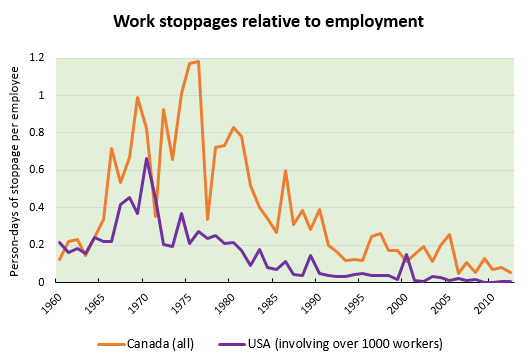Looking at the prevalence of strikes in the US over the past six decades, Doug Henwood writes,
Second Amendment fetishism aside, there’s an old saying that the working class’s ultimate weapon is withholding labor through slowdowns and strikes. By that measure, the U.S. working class has been effectively disarmed since the 1980s.
Doug then produces a graph showing a precipitous decline in the number of strikes in the US involving more than 1000 workers starting about three decades ago. Intrigued, two thoughts quickly crossed my mind. First, as is often the case, I wanted to see whether the same trend holds for Canada. Second, I was curious whether the decline had anything to do with the large scale of the strikes in the data Doug used.
Sure enough, the conclusions are (sadly) the expected ones: Canada exhibits the same trend and shows it to be one that is independent of the number of employees striking or locked out.

In my quick chart, I use a slightly different measure that allows for a direct comparison of the US to Canada and is not limited by the size of strike or lockout. The spike in the relative importance of work stoppages most prominent in the late 1960s and 1970s corresponds with growing labour militancy brought on and buoyed by the gains flowing from the post-war social settlement. The steady decline since that spike is but one more representation of the erosion of the power of the working class since the neoliberal response to the economic crises of the 1970s.
A couple things to add:
(1) Even though the data on strikes is depressing, we should be looking beyond the aggregate numbers for more localized trends and possibilities. Writing in a (freely-available) article from 2007, Linda Briskin notes that doing so
makes visible the local and the particular, and supports new ways of looking at overall patterns of labour militancy, highlighting very long and very short strikes, strikes of a few workers or those involving many thousands of workers, and strikes for first contracts. Although none of these may be of particular significance to aggregate data, they are of great consequence to workers, unions and communities.
While the decline of lost work time in general points to a defeat of worker power, there are details hidden in the aggregate data that can help uncover lessons for a revived labour militancy.
(2) As Doug himself noted in follow-up conversation to his original piece, the public sector in particular remains an object of hope for renewed militancy – and not only because it is the remaining bastion of significant union representation. Workers in the public sector can resist the logic of austerity at the source and help lead the fight for better and better-funded public services as an answer to this logic that affects the working class as a whole. Doing so, however, is difficult. For example, while over half of Canada’s unionized workers are in the public sector, the past eight years have only seen one year in which more than half of work-days lost to stoppages have also been in this sector. Alongside austerity for services, governments have been quick to impose settlements that cut into working conditions and limit the ability to strike. Perhaps that is why actions like the one just staged by Nova Scotia nurses point to the future. The nurses’ fight is not only centred on services (nurse-patient ratios) but is at the same time taking on the government’s ability to limit worker power via legislative fiat. On both counts, it is about rebuilding power or at least laying the ground for doing so.
3 replies on “Working class disarmed, Canadian redux”
As a progressive, I feel the war-mode dispute mechanism between workers and management of strike/lockout is inefficient because it’s arbitrary.
In the 1970s, labor had the upper hand which led to high inflation. Now, after 30 years of wage-busting from free-market reforms, globalization and inflation-fighting monetary policy (opportunistic disinflation,) management has the upper hand.
In order to have a level playing field, I believe that government should handle all labor disputes through a new model of arbitration: e.g. Ministry of labor arbitration. The goal would be to make this a democratic office (with democratic influence) not some fake technocracy (like that which governs the Bank of Canada.) So if wages are deflationary, workers can be given good raises; if wages are inflationary, they can be frozen. (Benefits can also be factored in.)
If you look at the graph, labor has probably been busted back to the 1940s. So instead of fighting for decades to get a fair deal, labor should look to create a new model.
Thanks Ron! I think the extent to which wages are inflationary is very much tied up with questions of bargaining power and the distribution of incomes between capital and labour. Monetary policy is a means of regulating the class bargain as much as fiscal policy and neither is free of power dynamics; the extent to which state institutions could be used to regulate the wage bargain in a truly democratic way is a reflection of how much the state itself is democratic and oriented towards the needs of people. I think neither is really the case at the moment and that is precisely why — while I agree that we may need a updated model — workers need a variety of elementary economic bargaining tools at their disposal to start effecting change.
[…] bargaining power visible in a (smaller then the US but present) decline of union density and the paucity of labour unrest. A range of factors including liberalized trade, real or imagined worries about profitability and […]